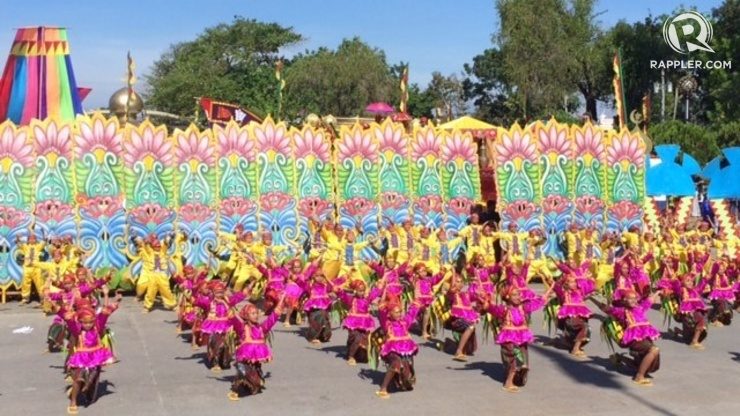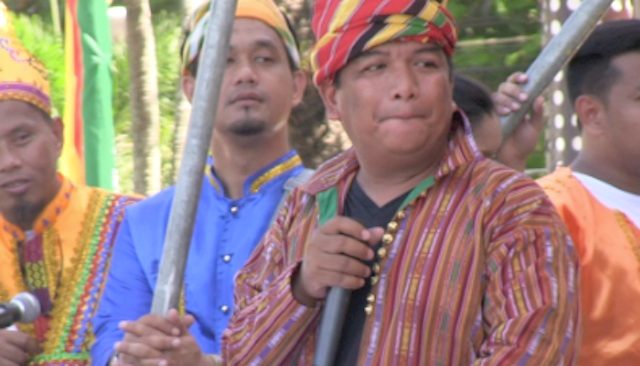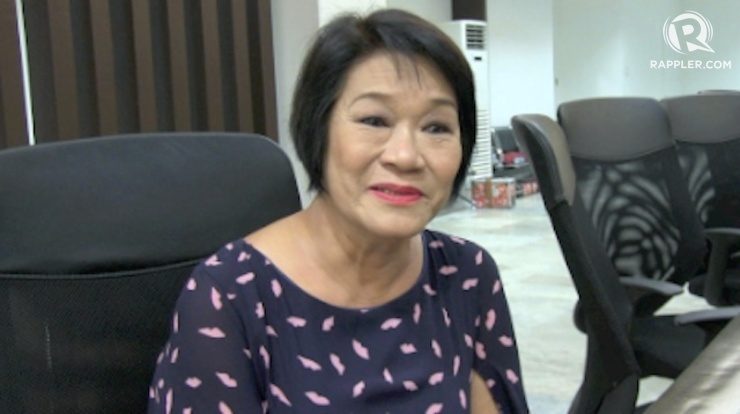SUMMARY
This is AI generated summarization, which may have errors. For context, always refer to the full article.

COTABATO CITY, Philippines – Clad in traditional Yakan garb, an emotional Mujiv Hataman, governor of the Autonomous Region in Muslim Mindanao (ARMM), issued a challenge to the next regional government as ARMM celebrated its 25th – and expected final – anniversary Wednesday, November 19.
“Kung sino man ang papalit, sana hindi lagyan ng anay ang nailagay na pundasyon,” Hataman said.
(To our successor, we hope you don’t put termites in the foundation that we have put up.)
With discussions on the creation of the Bangsamoro – a new autonomous government with greater fiscal and political powers – underway in Congress, the ARMM is in a state of transition.
If everything goes according to plan, the Bangsamoro will take over by the 2nd quarter of 2015 once the proposed law is approved in Congress and through a plebiscite.
Hataman, the first-ever member of the Yakan tribe to be a governor, considers himself as a reformist politician, whose most popular achievement is perhaps his move to rid ARMM of ghost employees.
ARMM was created under the government of the late President Corazon Aquino as a move to grant Muslim provinces more autonomy and address some of the grievances of Muslim rebel movements in Mindanao. But it’s been considered a failure largely due to mismanagement by previous Muslim leaders.
President Benigno Aquino III himself called it a “failed experiment.” He appointed Hataman officer-in-charge of ARMM in December 2011 with the end goal of making him the transition leader to a stronger Bangsamoro regional government.
Cash gifts
In its final year, the regional government did not scrimp on festivities to mark its 25th anniversary in a month-long celebration.
Just for Wednesday’s activities, a total of P500,000 in cash is set to be raffled off to employees, with 10 getting the chance to win P50,000 each.
A house and lot from ARMM’s housing project in Datu Odin Sinsuat was awarded Tuesday and another will be raffled off Wednesday night.

The ARMM complex was turned into museum as 5 tribal groups from Maguindanao, Tawi-Tawi, Sulu, Basilan and Lanao del Norte created mini villages depicting traditional culture.
The best mini village was set to win P1 million in cash prize while the 2nd placer will get P450,000 and the rest P200,000.
Aside from the regional government, different regional department pitched in for the costs, Hataman said.
The celebrations show that ARMM is all set for its expected curtain call to punctuate its recent milestones in its short but turbulent history.
With two months left in 2014, the ARMM has already surpassed its targets, reaching a record-high investment of P3.3 billion. The ARMM also managed to grow by 3.6% in 2013, up from 1.1% in 2012.
For its achievements, Hataman quipped: “Ang (concern) ko nga ngayon, baka maraming aayaw sa BBL (Bangsamoro Basic Law) dahil mas nagustuhan nila ang ARMM. (Our concern now is that maybe more would not support the BBL because they prefer the ARMM.)
But ARMM has had a difficult past.
ARMM’s past problems
The story goes that the typical work routine in the ARMM back then was “Republic Act 1530,” where officials only reported for work on the 15th or 30th day of the month to get their salaries.
The Office of the Regional Governor in the ARMM was accessible only to a few, and even employees themselves found it difficult to set appointments with high officials.
Social and basic services were almost non-existent. Violence continued to persist – highlighted even more by the 2009 Maguindanao massacre, which killed 58 individuals and caused the suspension of then ARMM Governor Zaldy Ampatuan, a principal suspect in the gruesome murders.
Despite recent reforms, the fact remains that the ARMM continues to lag behind the rest of the country in terms of development.

What ARMM under Hataman has done is set the direction for the Bangsamoro, said Father Jun Mercado, one of Hataman’s consultants. (Editor’s note: An earlier version of this story gave the wrong last name for Mercado. We regret the error.)
For Hataman, the challenge for the next leadership is how to sustain the reforms he introduced.
Transition
When he was formally elected into office in 2013, Hataman knew it was a term that he may not be able to complete.
By then, negotiations with the Moro Islamic Liberation Front, the country’s largest organized armed group, was already in its final stages after the signing of a peace roadmap in October 2012. A final peace agreement was signed in March – the basis of the proposed law for a new autonomous government now being discussed in Congress.
Nothing is final until the law is passed. While Congress technically has the option to reject the law, Hataman does not entertain such scenarios.
“Hindi pwede na hindi mangyari. Kailangan, dapat mangyari,” Hataman said in a press conference. (It has to happen.)
Hataman believes that the BBL is better than the ARMM. One of its most vital differences, he said, is the proposal to award the Bangsamoro with automatic appropriations, where its budget would be computed through formula, doing away with the need to require the region to have its budget approved by Congress.
Emotions high
Hataman had been holding back tears since Tuesday night when the regional government, for the first time, recognized exceptional employees, including those who had been working in the same building since the beginning.
More than 30 employees served under all 8 governors – from first govenor Zacaria Candao, to Moro National Liberation Front (MNLF) founding chairman Nur Misuari, jailed governor Zaldy Ampatuan up to incumbent governor Hataman, among others.
For employees who served ARMM since its early stages, the regional government was not a mere experiment.
“Actually, hindi ko nga alam na eksperimento lang pala ito dahil para sa akin nanungkulan ako ng buong katapatan at buong galing kung ano ang aming maibabahagi. Kung ganoon man ang pagtingin, siguro dahil marami pa ang nakikita nilang dapat gawin,” said ARMM Regional Treasurer Kanggo Umal.
(Actually, I didn’t know that this was just an experiment because I served it with all my heart and my abilities. If that’s how they look at it, maybe they see that we can do more.
There are concerns among the 32,000 ARMM employees, which includes 26,000 public school teachers, about what would happen to their jobs once the transition authority takes over until the election of new officials in 2016.
Under the final peace accord between the government and the MILF, the transitional body will be led by the MILF.

Some older employees who may find it hard to look for other jobs are at risk of losing their livelihood, said Elizabeth Nataño, ARMM senior administrative assistant IV.
Nataño has served the government all her life and was even part of the predecessor of the ARMM known as Lupong Tagapagpaganap.
Nataño said similar uncertainties over the tenure of regional employees were also felt when the then Lupong Tagapagpaganap was abolished to establish the ARMM in 1990.
“Those who have not experienced (the transition), they are apprehended. But for us who had already experienced how to be abolished, we take it lightly and think maybe the next one will like us. Let’s reapply. For those who are new, that’s the way it is. Some of us are old but not yet near retirement age,” she said.
Asked what would happen to these employees, Hataman said the answer would depend on what kind of law Congress would pass.
The central government has given assurances that public school teachers, which comprise more than half of ARMM employees, would be retained.
The rest would be covered by security of tenure laws, government peace officials said. But what about those who are considered old but not yet near retirement age, like Nataño?
There is no immediate answer at the moment but a team composed of representatives from the central government, the MILF and the ARMM has been established to plot the transition from the ARMM to the Bangsamoro. Hataman said the team has met at least 6 times.
Congress hopes to pass the proposed law by March and the central government aims to conduct the plebiscite soon after that to give the MILF-led transition authority at least one year to govern.
At the entrance of Hataman’s current office in Cotabato City, all guests are greeted by a small billboard showing a countdown to the number of days left before the ARMM steps down and the Bangsamoro takes over. They hope it’s a countdown to something much better. – Rappler.com
Add a comment
How does this make you feel?
There are no comments yet. Add your comment to start the conversation.